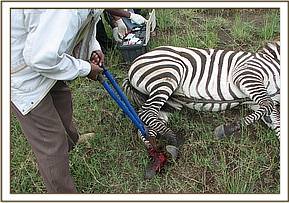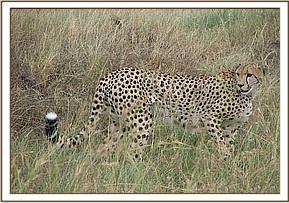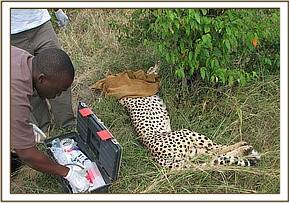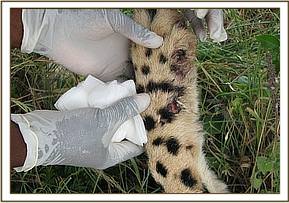Summary In the month of April, 2010, there was a lot of rainfall in Mara and most parts of the reserve were quite inaccessible
Summary In the month of April, 2010, there was a lot of rainfall in Mara and most parts of the reserve were quite inaccessible. The Central Rift veterinary unit was involved in opportunistic tissue samples collection from both wildlife and livestock to be analyzed for Bovine tuberculosis disease surveillance and research. The other veterinary interventions cases included the desnaring and treatment of an adult female zebra at Suswa area and treatment of a cheetah which sustained serious bite wounds from hyenas while fighting over a prey. Investigations are still on to confirm the cause of deaths of 3 lions suspected to have been poisoned in Lemek area of Maasai Mara. Relevant samples have been sent to the government chemist to identify the toxin, the results are awaited. Most wildlife species are still outside the reserve into the dispersal areas to avoid wet conditions and high grass levels in the reserve. This is likely to increase incidences of human-wildlife conflict within the surrounding community areas with predators attacking livestock and herbivores destroying crops. Rescue and treatment of a snared female zebra in Suswa area This was a case of a female adult zebra that had been sighted with a tight wire snare cutting through the tarsal joint area of the left hind leg; the wire was quite tight and was cutting deep through the muscles to the bone. There was a lot of hemorrhage and the animal was visibly in pain. They were only two zebras within that area, the rest of the herds could not be seen around an indication that the injured zebra could not keep pace with rest and were left behind. The veterinary team decided to capture the zebra then remove the snare and treat the inflicted injury in order to relieve pain and suffering. The zebra was captured by darting using 5mgs of etorphine hydrochloride combined with 80mgs of xylazine hydrochloride on the right shoulder. It took about 5 minutes for the drug to take effect and the animal went recumbent. The wire was immediately cut, retrieved from the wound and removed completely leaving an extensive wound on the tarsal joint, the bones were still intact and no fracture had occurred so it had only sustained soft tissue injuries. After removing the wire, the wound was cleaned and treated using 10% hydrogen peroxide and a tincture of iodine applied topically on it and later sprayed using oxytetracycline spray. Further treatment included administration of long-acting antibiotics and dexamethasones to relieve pain and reduce the inflammatory process. The animal was then revived from anaesthesia using 12mgs of diprenorphine hydrochloride combined with 10mgs of atipamezole hydrochloride administered through the jugular vein and the animal rose up after 2 minutes to join the other zebra nearby. Treatment of an injured female cheetah (Acynonyx jubatus) near Simba lodge Maasai Mara One of the adult female cheetahs in was reported to have sustained severe injuries on the palmer of the right front leg near Simba lodge in Maasai Mara. It was in a lot of pain and preferred lying down under the shrubs near a small pool of water all day. It had difficulties in walking and could be seen limping while lifting the injured leg off the ground to avoid pain. The wounds were suspected to have been caused by hyenas while struggling to snatch a kill from the cheetah a few days ago. The veterinary team from Maasai Mara responded in good time to treat the cheetah that could barely move. Chemical restrain The cheetah was found lying under the shrubs and was darted from a close distance using 150mgs of ketamine combined with 150 micrograms of medetomidine hydrochloride on the left thigh, it took about 8 minutes for the drug to take effect. It was then blindfolded and transferred to a cool shade under a tree from where it was examined and treated. Both the eyes were covered with opticlox® eye ointment to avoid desiccation and conjunctivitis while the cheetah was recumbent. Examination and treatment The cheetah was in a very good body condition and the vital physiological parameters were monitored and recorded as follows; Respiration rate 28 cycles/minute, deep and regular, pulse rate of 90 beats/minute, strong and regular, body temperature was 38 degrees Celsius, all the mucosal membranes had pink normal colour and capillary refill time (CRT) was 2 seconds. It had some external parasites such as ticks and lion flies on the skin. The cheetah had several small deep and extensive wounds penetrating into the muscles with some pus oozing from the wounds. The leg was already swollen and seemed much inflamed and painful. Treatment The wounds were well debrided and cleaned using a clean water and then hydrogen peroxide; it was also topically treated using a tincture of iodine applied on it and then sprayed by oxytetracycline spray. The animal was further treated using antibiotics (Amoxycillin) Betamox®, multivitamins and dexamethasone. Samples collection Blood samples were collected in EDTA coated tubes and plain tubes coated with clot retractor and kept in a cool box, tissue and hair samples kept in ethanol solution and ectoparasites such as ticks and lion flies collected and stored in 70% ethanol. These samples were processed and stored in KWS lab for further analysis and for health monitoring purposes. Anaesthesia revival After treatment, the animal was revived from anaesthesia after about 45 minutes using 40mgs of Atipamezole Hcl administered intramuscularly, it took about 5 minutes to rise up, it was still in pain and unable to hunt but would be supported by the other cheetahs which occasionally came to stay with her. Prognosis The prognosis was good after treatment because it had not developed septiceamia and still had good appetite and good body condition. The wounds were only affecting soft tissues and no bone infection or joint infection had set in. It was to be monitored on a daily basis by security rangers who would report on its progress regularly to the veterinarian just in case it would require further treatment or any assistance to enhance its recovery. Conclusion During the month of April, 2010, the Mara veterinary unit responded to all reported cases of sick and injured wildlife species within Maasai Mara National Reserve as highlighted in the report. Kenya Wildlife Service acknowledges the support of David Sheldrick Wildlife Trust (DSWT) towards provision of prompt veterinary services to wildlife in Maasai Mara ecosystem, Central Rift region and Ruma National park. Report by: Dr. Domnic Mijele









